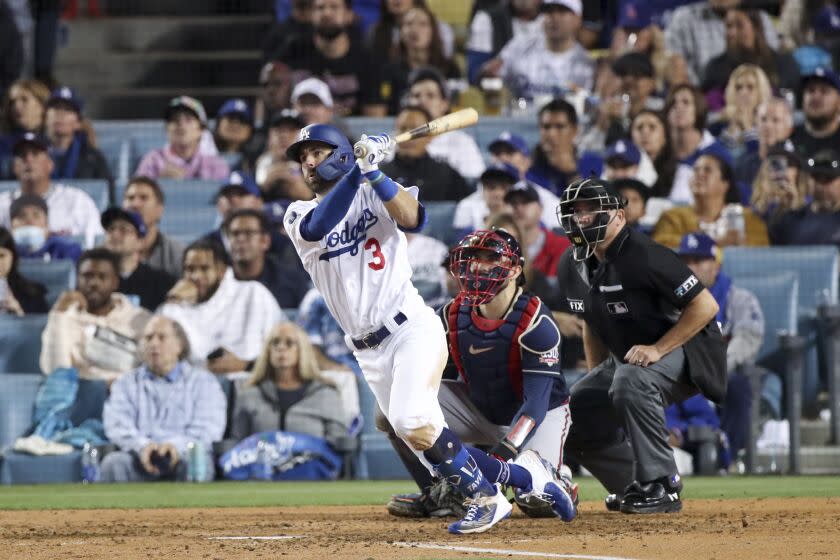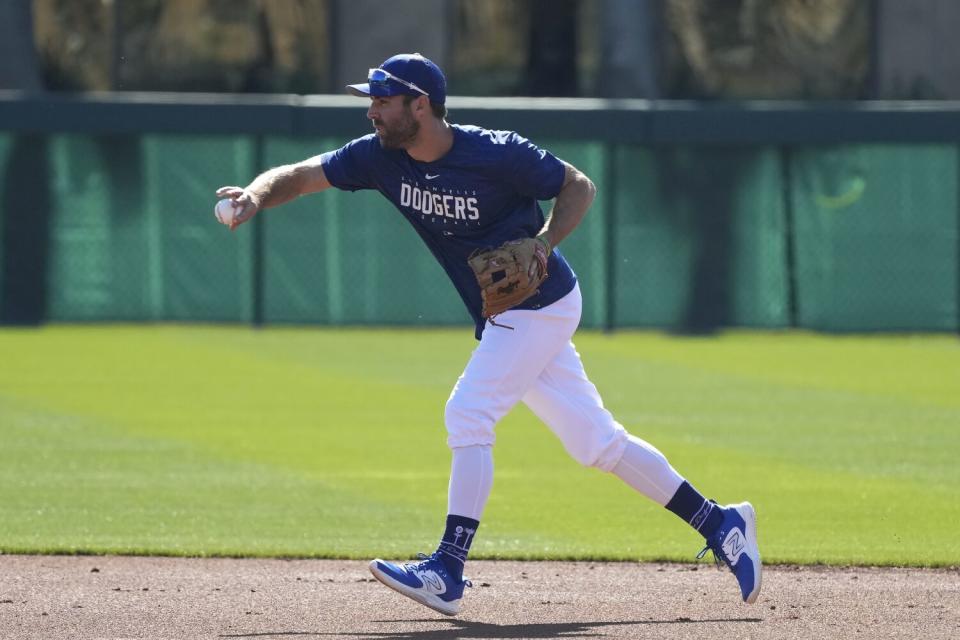
There’s a note-taking app on Chris Taylor’s phone that the Dodgers outfielder opens all the time, a simple yet useful system he long ago developed to track his ever-evolving swing.
Within it, the 10th-year veteran has kept a catalog of hitting tips, from mental cues and mechanical feelings, to coaching advice and personal observations.
Many of them go back years, originating from the career-altering swing changes Taylor made during his emergence with the Dodgers in 2017.
Ever since, he hasn’t been afraid to edit the list, routinely jotting new thoughts and crossing out old ones — especially during times like these, as he sets out to rectify his dismal 2022 performance this spring.
“Last season, I felt like I created some bad habits,” Taylor said. “So I’m kind of just trying to create a more efficient swing.”
It’s a task that could be key for Taylor and the Dodgers, with the club’s new-look roster desperately needing the 32-year-old to rebound from his injury-plagued and strikeout-prone struggles from last season.
After earning his first All-Star selection in 2021 and signing a four-year, $60-million deal with the Dodgers the following winter, Taylor’s performance plummeted last season. He batted just .221 with 10 home runs. He also struck out 160 times in 118 games, a 35.2% strikeout rate that trailed only Joey Gallo among MLB hitters with 400 plate appearances.
An offseason elbow surgery and a late-season neck injury contributed to Taylor’s struggles, but his swing seemed broken throughout the campaign. Not since his 2017 overhaul at the plate had the super utility player looked more overmatched and out of sync.
“Once you step in the box, it’s really difficult when you’re trying to think about your mechanics,” Taylor said. “And last year was just a constant battle of trying to find it and also perform.”
Not even referencing old notes could save Taylor — revealing a hard truth about many players similar to him who undergo major mid-career swing changes.
“The change works for a while,” Dodgers special assistant Chris Woodward said. “And then they hit a little bit of a plateau. Like, ‘I can’t feel the same way that I felt before.’ “
Woodward would know, especially when it comes to Taylor.
When the fifth-round draft pick broke into the majors with the Seattle Mariners in 2014, Woodward was part of the club’s coaching staff.
When Taylor was traded to the Dodgers in 2016, after three underwhelming seasons that left his future in doubt, Woodward was the Dodgers’ third base coach.
Woodward was as impressed as anyone by Taylor’s changes in 2017, when he transformed his natural slap-hitting motion by adding a bigger leg kick, improving his pre-swing hand positioning, and exploding through the ball with astonishing frequency.
“It was way different,” said Woodward, who left the Dodgers in 2019 to manage the Texas Rangers before returning this offseason in a part front-office, part on-field-instruction role. “He needed to make some adjustments. There were some things he needed to add.”
Taylor became an integral piece of Dodgers teams that won three National League pennants and one World Series from 2017 to 2021. In each of those seasons, he had an on-base-plus-slugging percentage of at least .775 while playing multiple positions, providing the club with much-needed defensive versatility. He even reached the 20-home run mark twice, something that seemed unthinkable after he hit one in his first three big league seasons.
But in the same way a renovated house requires constant upkeep, or a fixed-up sports car needs regular fine-tuning, Taylor had to consistently tinker with his swing — trying to maintain the same intricate motion amid inevitable changes to his body and his mechanics .
And last year, that “high maintenance” approach, as manager Dave Roberts has termed it, finally caught up with him.
“I’ve seen so many hitters go through that,” Woodward said. “When you make a swing change, it usually feels pretty good when you first do it. And then once it becomes normal, your body adapts and your brain adapts. You get a little numb to what it feels like.”
Enter Taylor’s note-taking routine, which has given him a new perspective on his swing work this spring.
“Some of the thoughts that might have worked for me in the past eventually became too much, where I went too far in the other direction,” Taylor said, sounding similar to a golfer who got rid of a slice but now hooks too many drives . “Sometimes it takes a while to figure out what those adjustments are. I have to find new ways of getting to the positions I want.”
The clock is ticking for him to do so.

Coming into camp, Taylor appeared set for a likely outfield platoon role while he was working through his latest changes. After Gavin Lux’s season-ending knee injury, however, Taylor might have to be more of an everyday player, in line to be the back-up shortstop in addition to the primary center fielder.
Woodward said he’s been encouraged by Taylor’s progress so far, despite his three-for-16 performance in Cactus League games.
“The swing is on time, there’s consistency with it [the mechanics],” Woodward said. “It’s just a matter of time before he starts hammering balls.”
Roberts also remains optimistic about Taylor rebounding this season, although he noted he was still “hesitant” to make any defining assessments this early in spring.
“There’s a recalibration of the body,” Roberts said. “I know our guys are doing the best they can to kind of get him dialed in and keep it. But there are a lot of moving parts.”
Taylor, who went to Driveline over the winter to help expedite his adjustments, offered a similar self-evaluation. Although he’s felt better in the batting cage in recent days, he acknowledged there are still a lot of variables — from his approach to hand position — that need to be addressed.
“No, it’s not fun for me at all,” he said with a lighthearted laugh when asked if he enjoyed the challenge of his process. “I would love to just have the same thoughts every day.”
As he discussed each nuance and nuisance, standing at his locker in the Dodgers’ Camelback Ranch clubhouse this week, Taylor looked over his shoulder and nodded enviously at the stall belonging to teammate Freddie Freeman.
“I’m jealous of guys like Freddie, who’s had the same swing his whole career,” Taylor said. “Guys like that, they’re gifted. Not to say he doesn’t work his ass off. But they were gifted to hit and have a great swing.”
For Taylor, hitting in the majors has never come that simply.
He has the crossed-out cellphone notes to prove it.
This story originally appeared in Los Angeles Times.